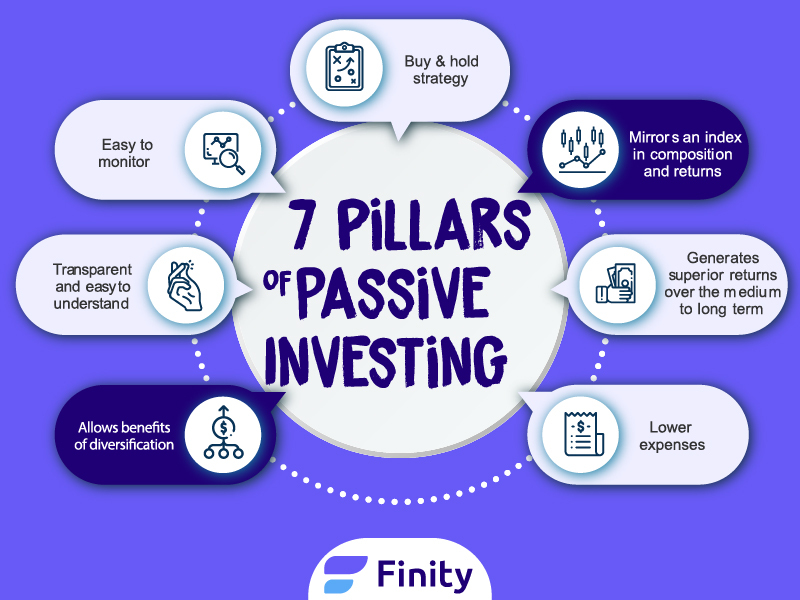
Passive investing is an already established style of investing the world over. Most developed nations have seen passive funds do well and in some cases even better than active funds. One of the primary reasons why an increasing number of investors are inclining towards a passive investment strategy is the lower costs. In India, passive investing is yet to pick up pace and is in a very nascent stage.
Passive funds that follow the Nifty index are known to have done comparatively well since the index has given a return of over 18% CAGR (compounded annual growth rate) in the past 22 years.
The question that new investors often ask is how does a passive investment strategy work?
To address this question, we have put together 7 key pillars that this strategy is based on. This will help investors discover different aspects of a passive investment strategy and allow them to adopt it for investment portfolio enhancement.
1. Passive funds are easy to monitor
Passive investment requires a long-term commitment and the investment corpus is benchmarked to an index. The idea is to replicate the performance of an index by investing in the same securities as the index and in the same proportion as the index. Thus, the portfolio remains relatively unchanged for the entire investment duration. This makes a passive investment strategy easier to monitor, as it doesn’t require portfolio modifications as per market movements.
2. Follows a buy & hold Strategy
The passive investment allows investors to adopt a buy-and-hold strategy. It is based on the premise that over a long period of time markets tend to go up. Well! Isn’t it true that the Sensex which stood at 5000 levels in the year 2000 is now just short of 53k? So, passive investing advocates you to just buy and hold your assets instead of repeatedly buying and selling based on various different strategies.
3. Mirrors an index in composition and returns
A passive investment is executed by replicating the composition of an index and expecting returns on the similar lines as the index. This means there is no individual stock selection required. It can be used by new investors, as mirroring an investment portfolio to an index could be an easy-to-understand option when compared to selecting individual securities without sufficient knowledge of the markets.
4. Generates superior returns over the medium to long term
Since passive investment requires long-term commitment, it can profit those who can remain invested for medium to long durations. As discussed earlier, passive investment is based on the buy and hold concept. Through investment in a diversified portfolio with low costs and a long-term investment commitment, investors can fetch returns that are comparable to the market average. Passive investing follows the premise that the market could deliver positive returns in the long run and therefore the portfolio must be held without significant changes for a longer tenure.
Fund managers managing active funds are increasingly finding it difficult to beat the benchmark of Index returns as they are meant to do. In fact, a scorecard brought out by Standard and Poor shows that 68.42% of the actively managed funds( in the large-cap category) have underperformed their benchmark Index over the 10yr period ending Dec 2020. For 1year period, 80.65% of the large-cap funds underperformed their benchmark. In these kinds of situations, isn’t it better to invest in Index funds that aim to replicate index returns rather than beat them?
5. Lower expenses
The cost of investment in passive strategy is lower since there is no frequent buying and selling of securities. As the Indian financial markets continue to evolve and mature steadily, the benchmark indices could appropriately represent the market returns. Passive investment does not require stock selections and modifications to weightages in the investment portfolio.
This also limits the need for fund managers in passive funds, as they only have to track the underlying indices. As a result, there are far lower fund management charges that lead to lower total expense ratios. Most active scheme expenses eat into the investors’ returns. Therefore, lower expense ratios in passive funds and lower expenses in passive investment help investors gain better returns.
6. Allows benefits of diversification
Passive investment includes indexing, and this means mirroring an index. This strategy automatically diversifies the investment portfolio across various sectors and companies. Diversification can protect an investor against sector-specific or company-specific downturns. By combining this strategy along with active investment, investors can gain far more returns than simply relying on actively managed investments.
7. Transparent and easy to understand
Actively managed funds allow complete control of investment selection to the fund manager. This could mean limited transparency for the investor since the portfolio could be changed frequently. When it comes to passive investment or investments in passive funds like index funds/ETFs, there is transparency, since the investor knows the exact composition of the underlying assets. It makes the portfolio easy to understand and track at all times.
Conclusion
Passive investing is yet to pick up in a big way in India. While actively managed funds are closely monitored, rated and discussed amongst investor circles, passive investing is yet to get its due attention despite the simplicity it can bring to an investor’s table.
FAQs on Passive Investing
- How do passive investors invest?
Passive investing requires buying an index fund that is mirrored to an indice or index. These funds are called passively managed or passive funds. The underlying holdings in these could be stocks, bonds, or other assets that make up the index being tracked. Commonly known passive funds are index funds and ETFs.
- What is passive investing, and what are its advantages?
Passive investing is an investment strategy for long-term investors. It aims to extract maximum returns from the market by mirroring an index and does not involve frequent trading. It helps investors to reduce the charges or fees involved in active trading or active investment.
- Is passive investing less riskier?
Passive investment or investing in Index funds or ETFs are linked to security markets which are subject to volatility. So it can’t be said that passive funds are any less riskier than other equity mutual funds.
- Which is an example of passive investing?
Passive investment can include multiple strategies. Some commonly used investments under this are index mutual funds or ETF. Mutual funds and ETFs hold portfolios of stocks, bonds, precious metals, etc. ETFs are traded on an exchange.
- Is active or passive investing better?
Active investments are generally expensive as compared to passive since active investments involve frequent stock or securities selection as per market movements. On the other hand, passive investment is about mirroring an index and therefore does not require constant modifications in a portfolio.



























